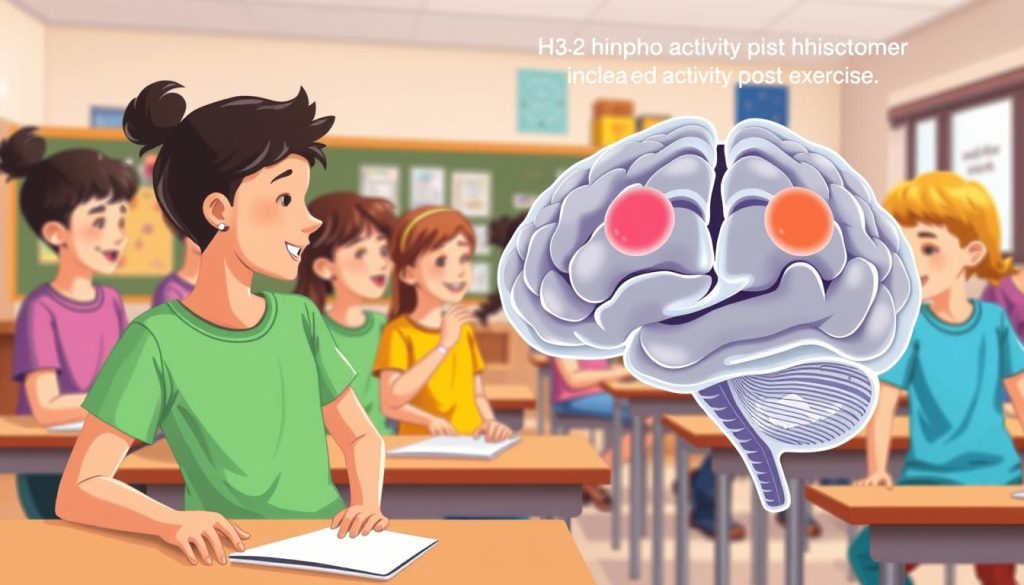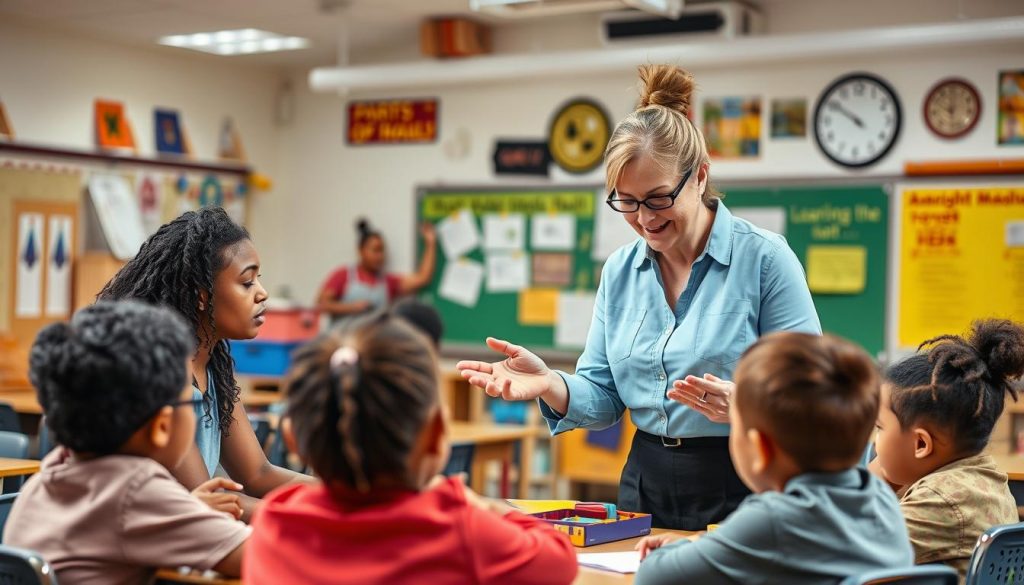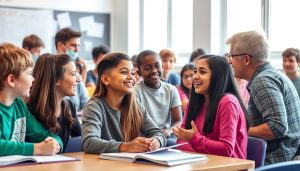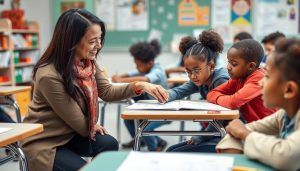The Fundamentals: How the Brain Changes as We Learn
Figure 1: Neural connections form and strengthen during learning, physically changing brain structure.
Every time a student masters a new concept or skill, their brain physically changes. This remarkable process, known as neuroplasticity, involves the formation of new neural connections and the strengthening of existing ones. When we learn, our neurons—the brain’s primary cells for processing information—create and modify synapses, which are the junctions where information passes from one neuron to another.
Neuroscientist Donald Hebb described this process with the phrase “neurons that fire together, wire together.” This means that when neurons are activated simultaneously during learning, the connections between them strengthen. This physical restructuring is the brain’s way of encoding new knowledge and skills, making them more accessible for future use.
For K12 teachers, this has profound implications. The traditional view that intelligence is fixed at birth has been thoroughly debunked. Instead, research shows that with appropriate stimulation and learning experiences, students’ brains continue to develop and adapt throughout their educational journey. Effective teacher skills include recognizing this potential for growth and designing instruction that capitalizes on the brain’s natural plasticity.
“Learning changes the physical structure of the brain. These structural changes alter the functional organization of the brain; in other words, learning organizes and reorganizes the brain.”
– National Research Council, How People Learn: Brain, Mind, Experience, and School
Critical Periods: When and How the Brain Changes as We Learn
Research has identified certain developmental windows when the brain is especially receptive to specific types of learning. These “critical periods” represent times when particular neural circuits are highly plastic and responsive to environmental input. For instance, language acquisition occurs most naturally during early childhood, when the brain’s language centers are developing rapidly.
However, it’s important for teachers to understand that while some skills may have optimal learning periods, the brain remains adaptable throughout life. Adult neurogenesis—the creation of new neurons—continues even in mature brains, particularly in the hippocampus, a region crucial for learning and memory formation.
Figure 2: Critical periods of brain development across childhood and adolescence.
Understanding these developmental timelines can help teachers optimize their instructional approaches. For example, while early elementary years are ideal for building foundational language skills, adolescence brings enhanced capacity for abstract reasoning and critical thinking. Developing teacher skills in recognizing and responding to these developmental windows can significantly enhance learning outcomes.
Key Insight for Teachers: While certain skills have optimal learning windows, the brain remains plastic throughout life. Even adolescent and adult brains can form new neural connections with appropriate learning experiences.
The implications for differentiated instruction are significant. Students in your classroom may be at different developmental stages, requiring varied approaches to maximize their learning potential. Effective teacher skills include recognizing these individual differences and adjusting instruction accordingly.
Enhance Your Brain-Based Teaching Skills
Discover practical strategies for applying neuroscience research in your classroom. Our comprehensive guide provides step-by-step approaches to optimize learning based on how the brain naturally develops and processes information.
Memory Formation: The Core of How the Brain Changes as We Learn
Memory formation is central to learning, and neuroscience has revealed fascinating insights into how memories are created and stored in the brain. Understanding these processes can help teachers design more effective learning experiences.
Types of Memory Systems
The brain doesn’t store all memories in the same way. Different neural systems handle different types of information:
- Working memory – Holds information temporarily while we process it (limited capacity)
- Declarative memory – Stores facts and events we can consciously recall
- Procedural memory – Maintains skills and habits we perform automatically
- Emotional memory – Preserves experiences with strong emotional components
Teacher skills that address these different memory systems can significantly enhance learning. For example, teaching a complex concept might involve factual presentation (declarative memory), hands-on practice (procedural memory), and connecting the material to students’ lives (emotional memory).
The Consolidation Process
When students learn new information, it doesn’t immediately become a stable, long-term memory. Instead, memories undergo a process called consolidation, during which temporary neural connections become more permanent. This process explains why:
- Distributed practice is more effective than cramming
- Sleep is crucial for learning (consolidation happens during sleep)
- Reviewing material after initial learning strengthens retention
- Emotional states affect what we remember
Skilled teachers leverage this understanding by spacing learning over time, encouraging adequate sleep, and providing opportunities for meaningful review and application.
Figure 3: The process of memory formation and consolidation in the brain.
Research has shown that emotional engagement significantly impacts memory formation. When students experience positive emotions during learning, neurotransmitters like dopamine are released, enhancing attention and memory encoding. This explains why learning experiences that incorporate novelty, personal relevance, and appropriate challenge tend to be more memorable.
Teacher skills that create emotionally supportive learning environments can therefore directly impact brain function and learning outcomes. By understanding how the brain changes as we learn, teachers can design instruction that works with these natural processes rather than against them.
Attention and Learning: Focusing the Brain’s Change Process
Attention acts as the gateway to learning. For the brain to encode new information, students must first focus on what’s being taught. Neuroscience research has revealed that attention isn’t a single process but involves multiple neural networks working together.
Figure 4: Neural activity during focused attention versus distraction.
The prefrontal cortex plays a crucial role in directing and sustaining attention. This brain region continues developing throughout childhood and adolescence, which explains why younger students often struggle with extended focus. Understanding this developmental trajectory helps teachers set realistic expectations and design age-appropriate learning activities.
Practical Applications for the Classroom
Chunk Information
Break complex content into smaller, manageable segments that align with working memory capacity. This reduces cognitive load and allows the brain to process information more effectively.
Incorporate Movement
Physical activity increases blood flow to the brain and can enhance attention. Brief movement breaks can help students refocus during longer learning sessions.
Use Novelty Strategically
The brain naturally attends to what’s new or different. Varying instructional approaches keeps students engaged and supports neural activation.
Teacher skills related to managing attention are increasingly important in our distraction-filled world. By understanding how attention networks function in the brain, teachers can create learning environments that support focused engagement. This might include minimizing unnecessary visual stimuli, providing clear learning goals, and incorporating regular attention resets throughout lessons.
“The brain doesn’t pay attention to boring things. We don’t pay attention to things that aren’t interesting. That’s one of the most powerful tools that a teacher has.”
– Dr. John Medina, molecular biologist and author of “Brain Rules”
Research has shown that multitasking significantly impairs learning by preventing the deep processing necessary for memory formation. When designing learning experiences, effective teacher skills include creating environments that minimize distractions and support sustained attention on meaningful tasks.
Transform Your Teaching with Neuroscience
Join thousands of educators who are applying brain research in their classrooms. Discover professional development opportunities that will enhance your teacher skills and improve student outcomes.
Stress and Emotion: Powerful Modulators of How the Brain Changes as We Learn
The emotional state of students significantly impacts how their brains process and store information. Neuroscience research has revealed that moderate, short-term stress can actually enhance learning by triggering the release of stress hormones that help encode memories. However, chronic or intense stress has the opposite effect, impairing the hippocampus and prefrontal cortex—regions critical for learning and executive function.
Figure 5: The relationship between stress levels and learning performance follows an inverted U-shaped curve.
This research explains why creating emotionally supportive classrooms is not just about student comfort—it directly impacts brain function and learning capacity. Teacher skills that help students manage stress and build emotional resilience can significantly enhance cognitive performance.
The Amygdala’s Role in Learning
The amygdala, an almond-shaped structure deep in the brain, plays a crucial role in processing emotions and attaching emotional significance to memories. When students feel threatened or excessively anxious, the amygdala can hijack cognitive resources, making it difficult to focus on learning tasks.
Understanding this brain mechanism helps explain why students experiencing trauma or chronic stress often struggle academically. Effective teacher skills include recognizing signs of emotional distress and implementing strategies to create psychological safety in the classroom.
Brain-Based Teaching Strategy: Begin class with a brief mindfulness practice or emotional check-in. Research shows that even short mindfulness activities can reduce amygdala activation and improve prefrontal cortex function, enhancing students’ readiness to learn.
Positive emotions, on the other hand, can enhance learning. When students experience curiosity, interest, or joy during learning activities, neurotransmitters like dopamine are released, which support attention, motivation, and memory formation. This explains why learning experiences that incorporate elements of play, discovery, and personal relevance often lead to better outcomes.
Teacher skills that foster positive emotional states—through supportive relationships, engaging instruction, and appropriate challenge—directly support how the brain changes as we learn. By understanding these emotional influences on brain function, teachers can create learning environments that optimize neural conditions for growth.
Sleep and Learning: Overnight Changes in the Learning Brain
Sleep plays a crucial but often overlooked role in how the brain changes as we learn. During sleep, the brain doesn’t simply rest—it actively processes and consolidates the day’s learning experiences. Neuroscience research has revealed that specific sleep stages serve different functions in memory consolidation.
Implications for Educators
This research has important implications for teaching practices and school schedules. Teacher skills that incorporate sleep science might include:
- Spacing learning over time rather than cramming
- Reviewing important material shortly before students sleep
- Educating students and parents about sleep’s role in learning
- Advocating for school schedules that align with adolescent sleep patterns
Adolescents experience a biological shift in their sleep-wake cycle, making it difficult for them to fall asleep early and wake early. Yet many middle and high schools start before 8:00 AM. Schools that have shifted to later start times report improved attendance, decreased tardiness, and better academic performance—all consistent with what neuroscience tells us about adolescent brain development.
“Sleep is the single most effective thing we can do to reset our brain and body health each day.”
– Dr. Matthew Walker, Professor of Neuroscience and Psychology at UC Berkeley
By understanding how the brain changes as we learn during sleep, teachers can better support their students’ cognitive development and academic success. This knowledge represents an important dimension of teacher skills in the 21st century classroom.
Physical Activity: Energizing How the Brain Changes as We Learn

Figure 7: Physical activity increases blood flow to key learning regions in the brain.
Exercise does more than build strong bodies—it builds better brains. Neuroscience research has demonstrated that physical activity has profound effects on brain structure and function, with direct implications for learning. When students engage in aerobic exercise, blood flow to the brain increases, delivering oxygen and nutrients that support neural growth and function.
Studies have shown that regular physical activity leads to:
- Increased production of BDNF (brain-derived neurotrophic factor), a protein that supports the growth and maintenance of neurons
- Enhanced development of new neurons in the hippocampus, a brain region crucial for learning and memory
- Improved executive function, including attention, working memory, and cognitive flexibility
- Better emotional regulation and reduced stress
These findings explain why students who are physically active tend to perform better academically. Teacher skills that incorporate movement into learning aren’t just making classes more engaging—they’re directly supporting brain development and cognitive function.
Practical Movement Integration Strategies
Movement Breaks
Brief, structured physical activities between learning segments can refresh attention and enhance cognitive processing. Even 3-5 minutes of movement can make a difference.
Active Learning
Incorporate movement directly into content delivery through techniques like gallery walks, four corners activities, or learning stations that require students to move around the classroom.
Embodied Learning
Use gestures and whole-body movements to represent concepts, especially in subjects like math, science, and language arts. This creates multiple neural pathways for learning.
The integration of movement into classroom instruction represents an evidence-based approach to optimizing how the brain changes as we learn. Teacher skills that leverage this connection between physical activity and brain function can significantly enhance student engagement and achievement.
Research Highlight: A 2018 study found that a single 20-minute session of moderate-intensity exercise improved attention and academic performance in children, with effects lasting for up to 2 hours after the activity.
Elevate Your Teaching with Brain-Based Strategies
Ready to implement neuroscience-informed approaches in your classroom? Our comprehensive course provides practical strategies that align with how the brain naturally learns.
Technology and Learning: Digital Influences on Brain Development
As digital technologies become increasingly integrated into education, understanding their impact on how the brain changes as we learn becomes essential. Neuroscience research provides insights into both the opportunities and challenges that technology presents for learning and brain development.
Memory and Digital Learning
The way we interact with digital information may affect how memories are formed and stored. Research suggests that when we know information is easily accessible online, we’re less likely to commit it to memory—a phenomenon called the “Google effect.” At the same time, interactive digital learning experiences that require active engagement can enhance memory formation through multiple neural pathways.
Teacher skills that optimize digital learning include designing activities that require deep processing rather than passive consumption, integrating retrieval practice, and helping students develop metacognitive strategies for digital environments.
Digital Wisdom for Teachers: Technology is neither inherently beneficial nor harmful for brain development—what matters is how it’s used. The most effective approaches leverage technology’s strengths while maintaining essential human elements of learning.
Understanding how the brain changes as we learn in digital contexts helps teachers make informed decisions about technology integration. Rather than viewing technology as a replacement for traditional teaching, neuroscience suggests it’s most effective when used to enhance human connection, provide personalized learning experiences, and extend learning beyond classroom walls.
Developing teacher skills in digital pedagogy represents an important dimension of 21st-century education. By applying neuroscience principles to technology integration, teachers can create learning experiences that work with—rather than against—the brain’s natural learning processes.
Practical Applications: Classroom Strategies Based on How the Brain Changes as We Learn
Translating neuroscience research into effective classroom practice requires thoughtful application. Here are evidence-based strategies that align with how the brain naturally learns and changes:

Figure 10: Brain-based teaching strategies enhance student engagement and learning outcomes.
Spaced Practice
Rather than covering material once and moving on, revisit key concepts at spaced intervals. This approach aligns with how memories consolidate in the brain, strengthening neural connections over time.
Teacher Skills: Creating spiraling curriculum plans, implementing systematic review, and designing cumulative assessments.
Retrieval Practice
Have students actively recall information rather than simply reviewing it. The effort of retrieval strengthens memory pathways and identifies knowledge gaps.
Teacher Skills: Designing effective questioning strategies, implementing low-stakes quizzing, and teaching students self-testing techniques.
Multimodal Learning
Present information through multiple sensory channels to create redundant memory pathways. This approach activates different brain regions, enhancing understanding and retention.
Teacher Skills: Creating visual supports, incorporating movement, and designing hands-on learning experiences.
Elaboration
Encourage students to connect new learning to existing knowledge. This process strengthens neural networks and creates more robust memory structures.
Teacher Skills: Asking “why” questions, facilitating discussions that connect concepts, and teaching comparison strategies.
Concrete Examples
Pair abstract concepts with specific examples. This approach bridges declarative and episodic memory systems, making learning more accessible and memorable.
Teacher Skills: Collecting relevant examples, using analogies, and helping students generate their own examples.
Dual Coding
Combine verbal and visual information to leverage multiple processing systems in the brain. This creates redundant memory pathways and enhances comprehension.
Teacher Skills: Creating effective visual aids, teaching visual note-taking, and designing integrated text-image learning materials.
These strategies aren’t just theoretical—they’re practical applications of what neuroscience tells us about how the brain changes as we learn. By incorporating these approaches into daily instruction, teachers can create learning experiences that work with the brain’s natural processes rather than against them.
Developing teacher skills in these evidence-based practices represents an important step toward more effective, brain-aligned education. The goal isn’t to completely transform teaching overnight, but rather to gradually incorporate strategies that enhance how students learn and remember.
Navigating Neuromyths: Separating Fact from Fiction
As neuroscience research on how the brain changes as we learn has gained popularity in education, it has also given rise to numerous misconceptions or “neuromyths.” These misinterpretations of brain research can lead to ineffective or even counterproductive teaching practices. Developing teacher skills in critically evaluating neuroscience claims is essential for evidence-based practice.
Figure 11: Distinguishing between neuroscience facts and common neuromyths in education.
| Neuromyth | The Reality | Implications for Teaching |
| We only use 10% of our brains. | Neuroimaging shows that all parts of the brain have active functions. No area is completely inactive, even during sleep. | Students’ cognitive potential isn’t limited by unused brain capacity. Focus instead on developing effective learning strategies. |
| People are either “left-brained” (logical) or “right-brained” (creative). | While some functions show lateralization, the brain works as an integrated whole. Complex thinking requires coordination across hemispheres. | Avoid labeling students as analytical or creative types. Instead, help all students develop both logical and creative thinking skills. |
| Students have specific learning styles (visual, auditory, kinesthetic). | While students may have preferences, research doesn’t support the idea that matching teaching to preferred “styles” improves learning outcomes. | Use multiple modalities for all students rather than trying to match instruction to perceived learning styles. |
| The brain is fully developed by early childhood. | Brain development continues well into adulthood, with the prefrontal cortex not fully mature until the mid-20s. | Recognize that students’ cognitive capacities continue to develop throughout their school years, particularly executive functions. |
| Certain “brain training” exercises can increase general intelligence. | Most brain training programs produce improvements only on the trained tasks, with limited transfer to other cognitive skills. | Focus on teaching content and thinking skills directly rather than relying on generic “brain exercises” to improve learning. |
Understanding these distinctions helps teachers make informed decisions about instructional approaches. Teacher skills that include critical evaluation of educational claims and a solid grounding in learning sciences can help educators navigate the sometimes confusing landscape of brain-based education.
“It’s important to distinguish between neuroscience, cognitive psychology, and educational practice. Each field contributes valuable insights, but we must be careful about how we translate between them.”
– Dr. Daniel Willingham, cognitive psychologist and author of “Why Don’t Students Like School?”
By developing a nuanced understanding of how the brain changes as we learn, teachers can avoid simplistic interpretations while still applying valid insights from neuroscience research. This balanced approach represents an important dimension of teacher skills in contemporary education.
Continue Your Professional Growth
Deepen your understanding of how the brain changes as we learn and earn professional development credits. Our research-based courses help you translate neuroscience into effective classroom practice.
Conclusion: The Learning Brain in Your Classroom
Understanding how the brain changes as we learn provides a powerful foundation for effective teaching. By aligning instructional practices with the brain’s natural learning processes, educators can create more engaging, efficient, and inclusive learning experiences for all students.
The key insights from neuroscience research highlight that:
- Learning physically changes the brain by creating and strengthening neural connections
- These changes occur throughout life, though certain developmental periods offer optimal windows for specific skills
- Factors like sleep, physical activity, emotional state, and social connection significantly impact brain function and learning
- Effective learning experiences engage multiple neural networks and provide appropriate challenge
Developing teacher skills that incorporate these insights doesn’t require a complete transformation of practice. Rather, it involves thoughtfully examining current approaches through the lens of how the brain learns and making strategic adjustments to enhance effectiveness.
As research in neuroscience and education continues to evolve, so too will our understanding of how to optimize learning. The most effective educators will be those who maintain a curious, evidence-informed approach to their practice, continuously refining their teacher skills based on emerging insights about how the brain changes as we learn.
By bridging the gap between neuroscience research and classroom practice, we can create learning environments that not only teach content but also develop the flexible, adaptive brains that students need for success in a rapidly changing world.
Ready to Transform Your Teaching?
Apply neuroscience principles in your classroom with our comprehensive resources and professional development opportunities. Join thousands of educators who are enhancing their teacher skills through brain-based approaches.





Social Connection: The Collaborative Brain in Learning
Humans are inherently social beings, and our brains have evolved to learn optimally in social contexts. Neuroscience research has revealed that social interaction activates neural networks that enhance learning and memory formation. When students engage in collaborative learning, multiple brain regions work together to process information, leading to deeper understanding and better retention.
Figure 8: Social learning activates neural networks that enhance memory and understanding.
The discovery of mirror neurons—cells that fire both when we perform an action and when we observe someone else performing the same action—helps explain why learning from others is so powerful. These specialized neurons allow students to internalize new skills and concepts by watching their peers and teachers.
Teacher skills that leverage social learning include designing effective collaborative activities, modeling thinking processes, and creating opportunities for peer teaching. These approaches don’t just make learning more engaging—they align with how the brain naturally processes and retains information.
The Social Brain and Motivation
Social connection also plays a crucial role in learning motivation. When students feel a sense of belonging and connection in the classroom, the brain releases neurotransmitters that enhance attention, memory, and emotional well-being. Conversely, social rejection or isolation activates the same brain regions as physical pain, creating conditions that inhibit learning.
Understanding how the brain changes as we learn in social contexts helps explain why classroom climate is so important for academic success. Teacher skills that foster positive relationships and create inclusive learning communities directly support optimal brain function for all students.
“The brain is a social organ, and our relationships with others are not a luxury but an essential nutrient for our survival.”
– Dr. Louis Cozolino, Professor of Psychology and author of “The Social Neuroscience of Education”
This understanding of the social brain has important implications for classroom practice. Effective teacher skills include creating opportunities for meaningful collaboration, fostering a sense of community, and addressing social-emotional needs alongside academic content.